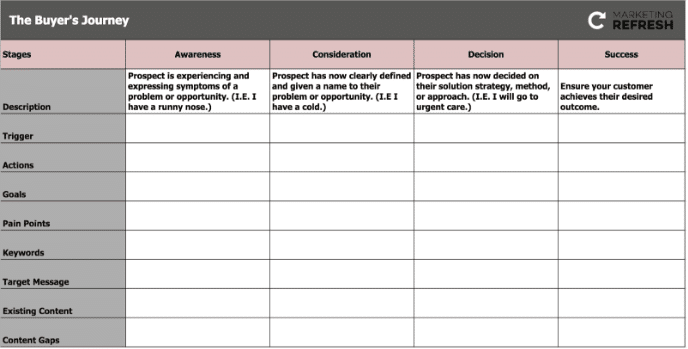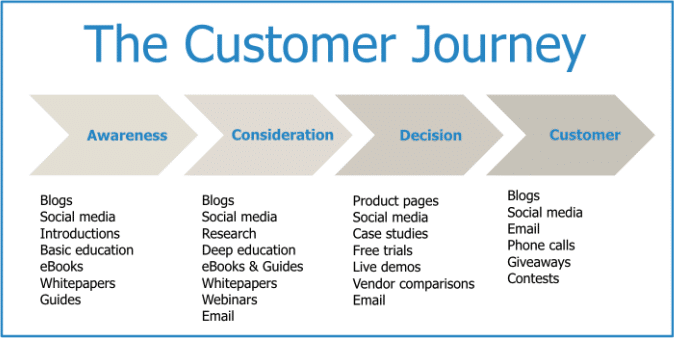A comprehensive content marketing strategy should include a lot more than just product and service pages that are optimized for prospects who are ready to buy. Your potential customers follow a journey as they prepare to make a decision and your content should, too.
Learn more about the customer journey and why it’s important in our latest Marketing Minute.
What’s the first thing you do when you don’t know the answer to a question? You Google it! Maybe before you even realize that the answer could lead you down the path to a purchase.
“Why is my car making a rattling sound when I turn?” If you find out there is an expensive fix down the road, you might be making a choice between repairing your car and buying a new one. And then once you make that choice, you have to make a decision as to which car you want to buy.
Buyers have dozens of questions and choices along their path to purchase. One of the most common questions I get from prospects looking for marketing support is, “why should my company waste time on leads that aren’t sales ready? I want to attract visitors who want to buy right now!”
But the average sales process takes six to seven touches before a close. Most leads follow a journey before opening their wallet. If you’re there in the beginning, you’re much more likely to close at the end.
What’s In a Customer Journey Map?
A customer journey map outlines each phase that a prospect experiences while they are researching their purchase decision:
- Awareness
- Consideration
- Decision
- Success
There are unique questions, pain points, and keywords associated with each of these phases. Understanding these differences will help you to better support your prospects with content. Once you pull a prospect into your funnel through a stage in the customer journey, you can nurture them toward a purchase.
Awareness Phase
The awareness phase of the customer journey likely occurs well before a prospect is aware that they need to buy a product or service. It’s the impetus that kicks them off on their journey—much like the ‘rattling sound’ in our car example from the video. Or perhaps for an issue that hits closer to home—a company that’s frustrated with the quality or quantity of their leads.
Awareness-phased prospects are the farthest out from being ready to purchase. Depending upon the length of your sales cycle, they could be as much as six months or a year out.
But that doesn’t mean they are low-quality leads. A robust marketing and sales funnel should include prospects at every phase so that you are continually nurturing new leads along the path to buying. The more contact the prospects have with you at the beginning, the more likely they are to trust you when it comes time to buy.
Consideration Phase
The consideration phase is typically identified as the point in which a customer is starting to weigh their options. They’ve put a name to their problem and they are considering which direction is best for them.
Circling back to our car example, the prospect has realized that the rattling sound is more serious than a stick caught in their tire. Perhaps they have a professional check it out and give them an estimate. Now, they have to decide between repairing the car that they have and buying a new one.
You find a lot of “this versus that” type of content in the consideration phase, along with questions starting with how, what, and where.
Decision Phase
The decision phase is the point that most business owners start their marketing content (bypassing the first two). A prospect who has entered this phase knows what they want to do and they just need to decide who is going to help.
Content supporting the decision phase of the customer journey outlines the value of your product or service and shows why a prospect should pick you over your competitor. In other words, does Toyota or Honda make the better car? While it’s a very important phase (arguably the most important to conversion optimization) it can’t be the only focus of a complete strategy.
Success
Lastly, a marketing strategy is not complete without a plan for how to market to your existing customers. We’ve all heard the old adage that it’s more expensive to acquire a new customer than to retain an existing one. Well, that means that you need to think about how to best use your valuable customer base.
Outlining the key identifiers, pain points, and goals of your ideal customers will help you to create content that encourages referrals and upsells—that means more business for you!
How to Apply the Customer Journey to Your Marketing Strategy
Once you have a thorough understanding of the customer journey and what your various personas are going through, you can develop a content marketing plan to address each stage. Not only should all four stages have their own message, but the type of content which will be most effective varies as well.
The following chart outlines the best content choice by customer journey stage:
A Complete Strategy Covers All Stages of the Journey
As you can see, your potential customers have a LOT of questions that are tangentially related to your business. This means that if you are a car company, your content marketing plan should include material going all the way back to common car problems and the support they need to take the next step.
Utilizing your marketing content to answer questions for every phase along the customer journey will help build trust with your prospects and optimize your funnel for conversion. Have questions about where to get started? We happen to love building out customer journey maps. We’re here to help!




